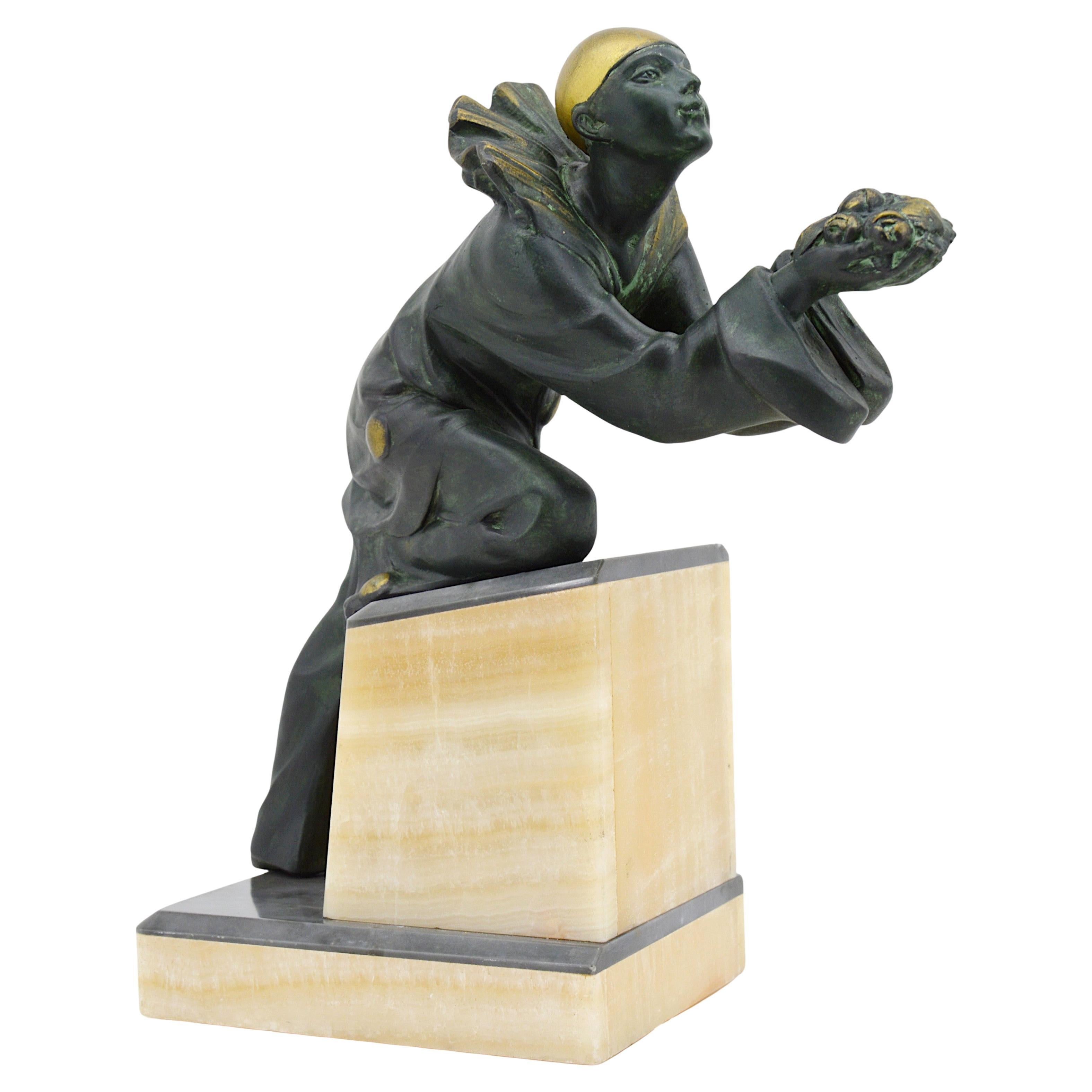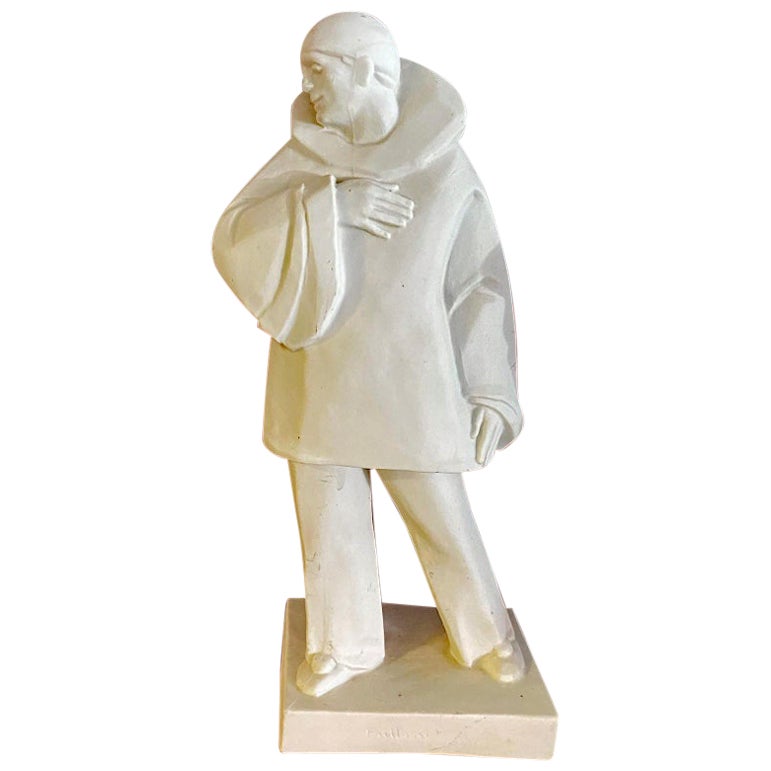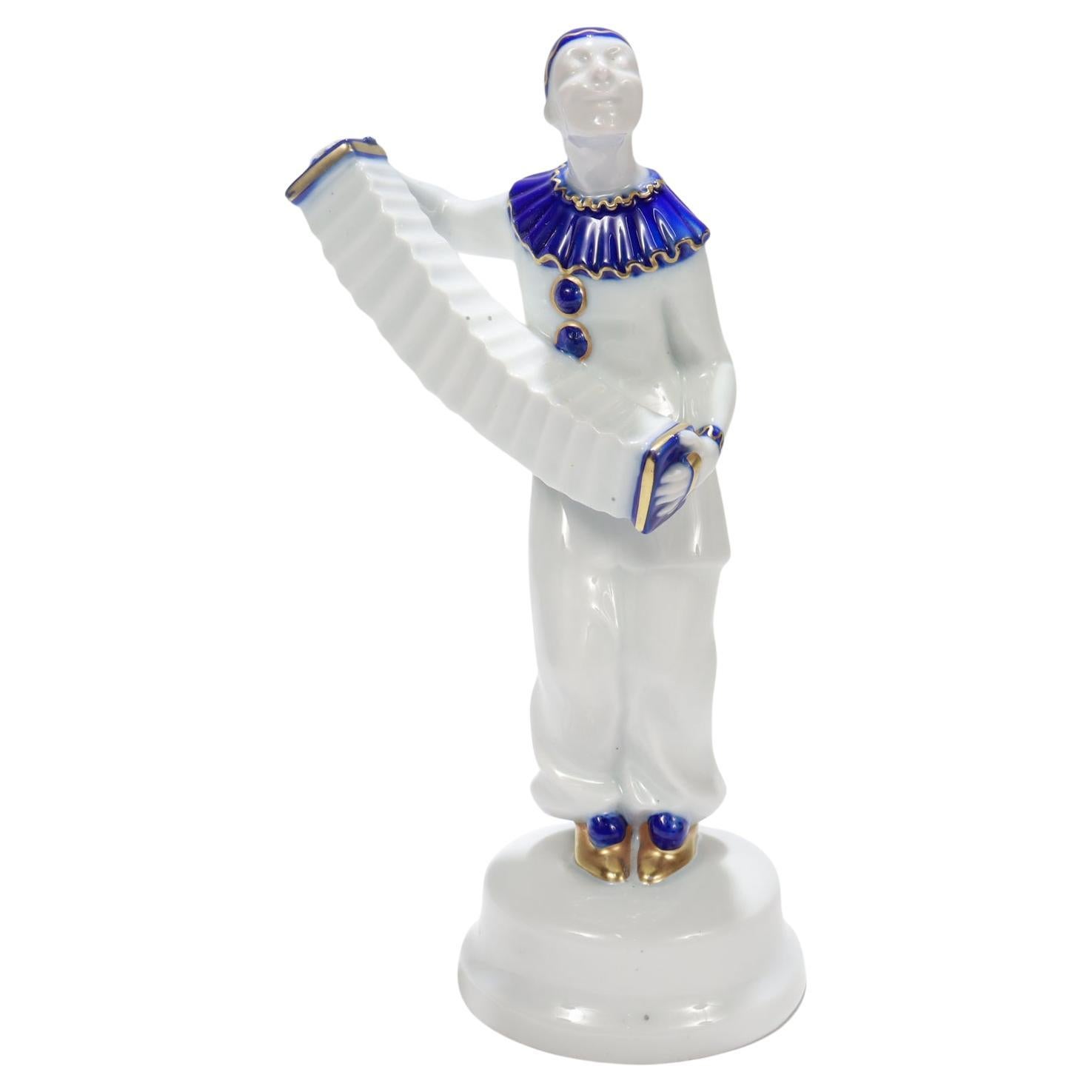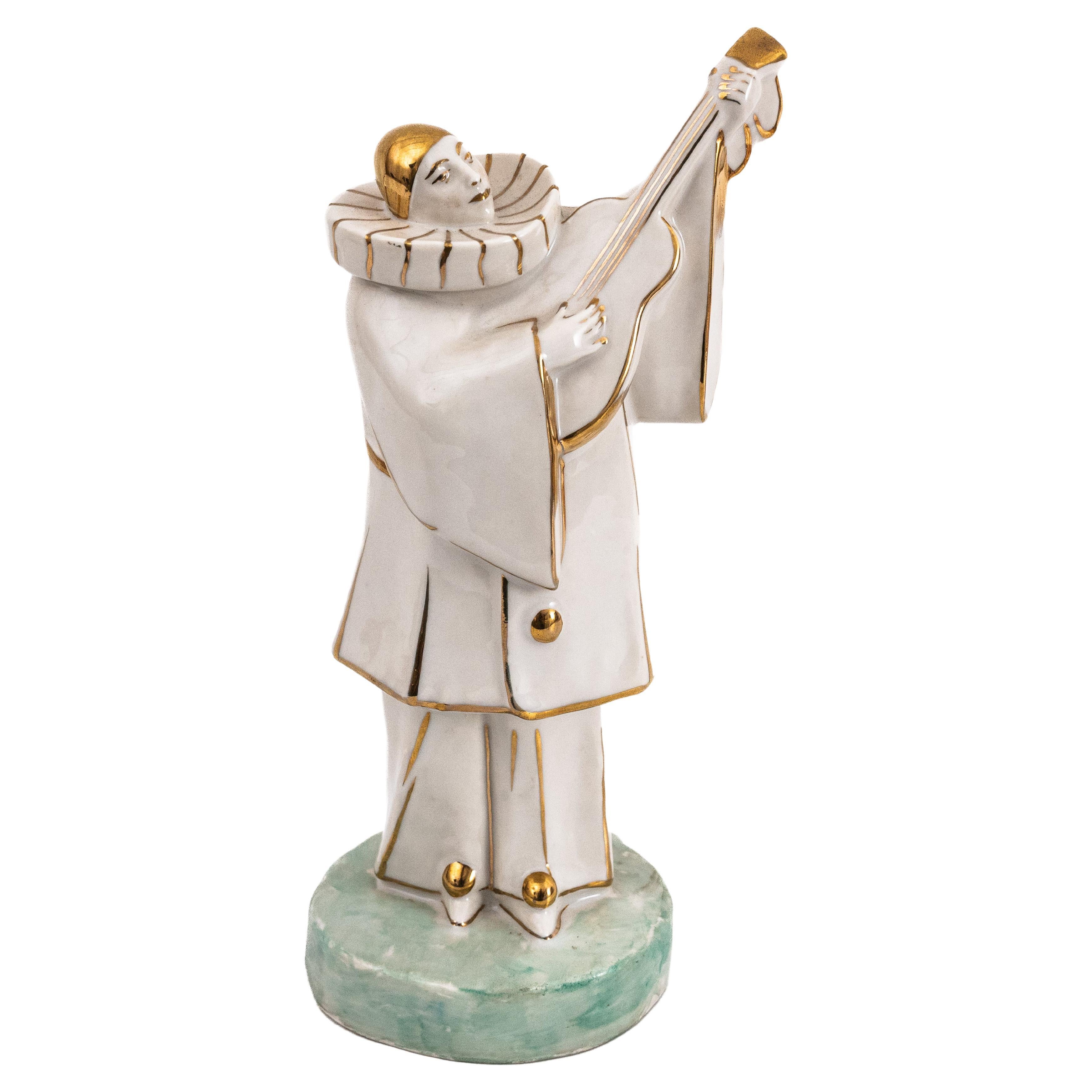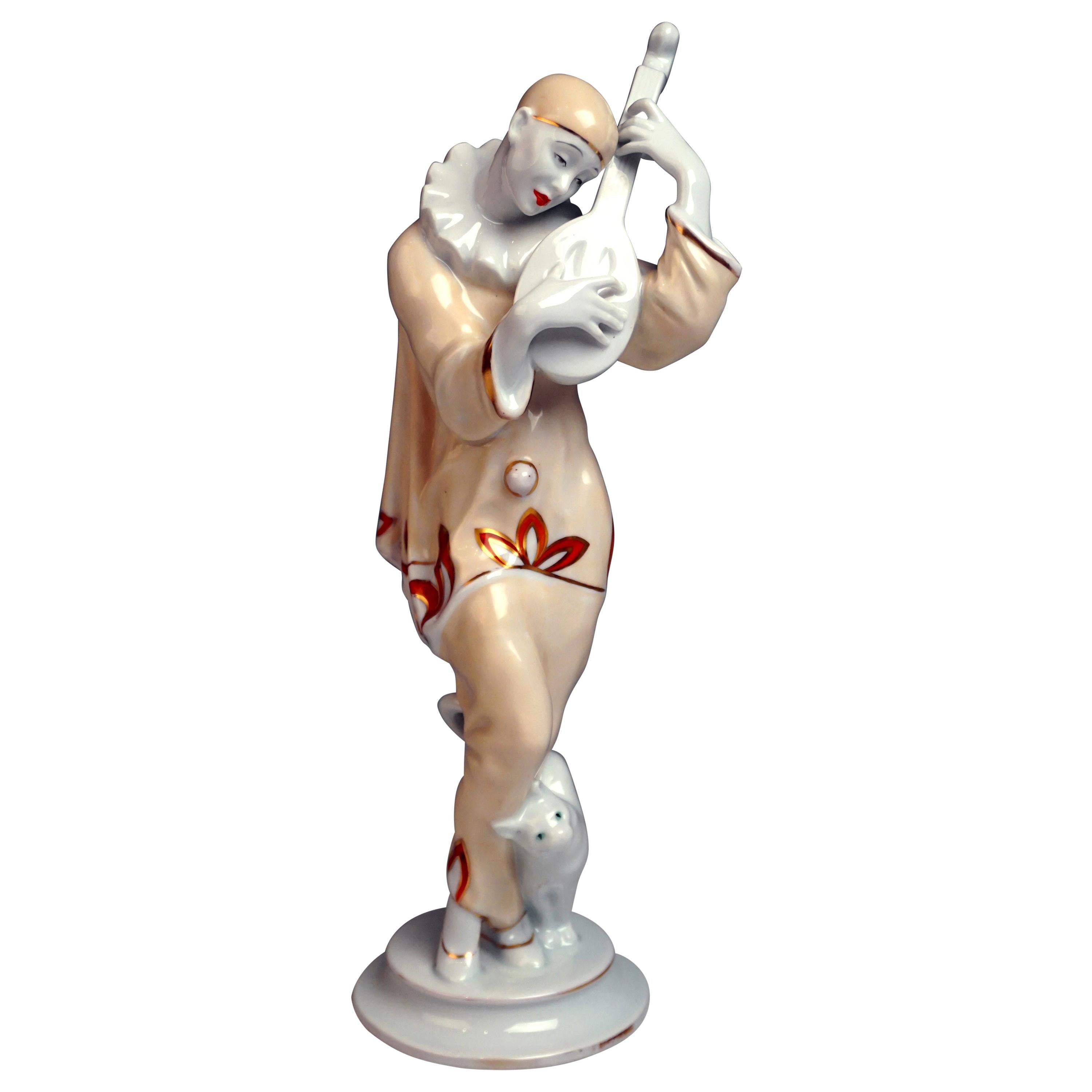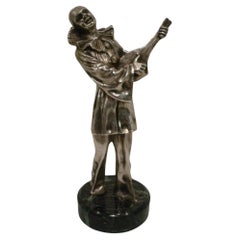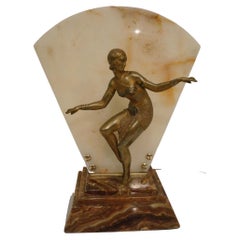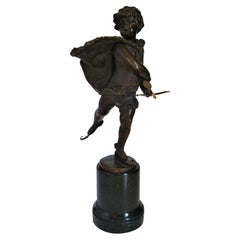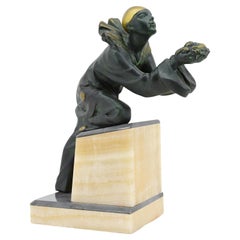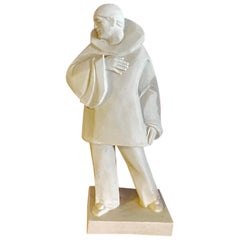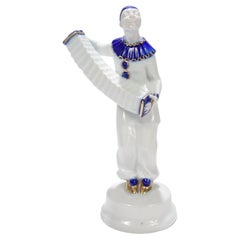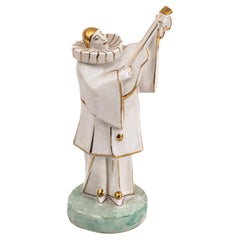Items Similar to Art Deco Signed Alabaster Pierrot Clown Sculpture, 1920s
Want more images or videos?
Request additional images or videos from the seller
1 of 12
Art Deco Signed Alabaster Pierrot Clown Sculpture, 1920s
$1,850
£1,376.09
€1,611.13
CA$2,581.38
A$2,888.63
CHF 1,508.31
MX$35,512.76
NOK 19,029.06
SEK 17,906.25
DKK 12,020.24
Shipping
Retrieving quote...The 1stDibs Promise:
Authenticity Guarantee,
Money-Back Guarantee,
24-Hour Cancellation
About the Item
Art Deco signed Alabaster pierrot clown sculpture.
Pierrot sculpture playing the mandolin.
The figure is signed, but i cannot read what it says.
We have specialized in the sale of Art Deco and Art Nouveau and Vintage styles since 1995. If you have any questions we are at your disposal. Pushing the button that reads 'View All From Seller'. And you can see more objects to the style for sale. Why are there so many antiques in Argentina?
In the 1880 – 1940 there was a grate wave of immigration encouraged by the periods of war that were taking place. 1st World War took place between 1914 and 1918 2nd World War took place between 1939 and 1945 The immigrants options were New York or Buenos Aires. Tickets were cheap and in Buenos Aires they were welcomed with open arms, as it was a country where everything was still to be done. Argentina was the country of new opportunities, labour was needed and religious freedom was assured, in many cases the of the family travel first until they were settled and then the rest of the family members join them. In the immigrant museum “Ellis Island Immigrant Building” in New York you can se the promotional posters of the boats that would take them to a new life. Between the years 1895 and 1896, Argentina had the highest DGP (gross domestic product) per capita in the world according to the Maddison Historical Statistics index, this situation arose due to the large amount of food being exported to European countries, which were at war. The Argentinean ships left the port of Buenos Aires with food, but they returned with furniture, clothes and construction elements, (it´s common to see this the old buildings of the historic neighbourhood of San Telmo, the beams with the inscription “Made in England)”, as well as many markets that were built in Buenos Aires, such us the San Telmo Market, whose structure was brought by ship and afterwards assembled in 900 Defensa Street. With the great influence of European immigrants living in the country, the children of the upper classes travelled to study in France, resulting in the inauguration of “La Maison Argentinienne”, on 27th of June 1928, in the international city of Paris, which hosted many Argentinians that were studying in Frace. It´s the fourth house to be built after France, Canada and Belgium, being the first Spanish-speaking one. Still in place today (17 Bd Jourdan, 75014, Paris, France). Many of the children of these wealthy families who attended international art exhibitions, museums and art courses abroad, took a keen interest in the European style. This is why Buenos Aires was at the time referred as “The Paris of South America”. Between the years 1890 and 1920 more than a hundred Palaces were built on Alvear Avenue the most exclusive avenue in Buenos Aires. Today some of these palaces have been transformed into museums, hotels and embassies. In the year 1936, the Kavanagh building was inaugurated, it was the tallest reinforced concrete building in South America. During 1994 the American Society of Civil Engineers distinguished it as an “international engineering milestone”, and it´s now considered a World Heritage of Modern Architecture. At the time was common to hire foreign architects such as Le Corbusier, who visited Buenos Aires/Argentina in 1929 and in 1948 he drew up the blueprints for a house built in La Plata City (which was declared a World Heritage Site). In 1947, the Hungarian architect Marcelo Breuer designed “Parador Ariston” in the seaside city of Mar del Plata. After an Argentinean student at Harvard University convinced him to come to Argentina. He worked on an urban development project in the Casa Amarilla, area of La Boca. The Ukrainian architect, Vladimiro Acosta, arrives in Argentina in 1928 and worked as an architect until que moved to Brazil. Antonio Bonet, a Spanish architect who worked with Le Corbusier in Paris, arrives in Argentina in 1937, where he carried out several architectural works and in 1938 designs the well-known BFK chair. Andres Kálnay, of Hungarian origin, made around 120 architectural masterpieces, among which the former Munich brewery stands out, he even made the furniture’s design. The German architect, Walter Gropius, director of the Bauhaus, lived in Argentina, where he wrote articles for “Sur” magazine and founded in Buenos Aires, an architectural firm with Franz Möller, who was also an architect, where he built two houses. At the same time several famous designers decided to immigrate to Argentina, among them we can find the well-known French designer, Jean-Michel Frank, who arrived in the country in 1940 and also worked for the Rockefeller family. Special pieces were made, which were sold exclusively in the country, such as the well-known German company “WMF”, who sold their products by catalogue, which were chosen by the ladies of high society in the list of wedding gifts, as well as the pieces designed by Christofle. The Swiss sculptor Alberto Giacometti, made special pieces for Argentinean mansions. In 1904 the first Jansen branch outside Paris was established in Buenos Aires, as the Argentinean clientele demanded a large amount of furniture, from the end of the 19th century to the mid-20th century. In 1970, the brand Rigolleau Argentina made pieces authorised by Lalique. The brands Maple and Thompson also set up shop in the country. The French plastic artist, Marcel Duchamp moved to Argentina in 1918-1919. Glass signed Gallé, Charder, Leverre, Schneider, Muller and other French firms. They were bought in flower shops and were given to ladies with beautiful floral arrangements. Some furniture manufacturers travelled to international fairs and bough the patterns to produce the furniture in Argentina, such as the furniture firm Englander and Bonta, who bought the patterns in Italy. It is worth mentioning that in Argentina we have the largest community of Italians outside of Italy, as it is estimated that 70 percent of the inhabitants have at least one Italian descendant, followed by Spanish immigrants. The most Important furniture stores in Argentina: Comte is founded in 1934 (under the direct management of Jean Michel Frank in 1940). Nordiska (Swedish company established in 1934). Churba in 1960, a company that brought foreign designers to present their furniture in the country: Denmark: (Arne Jacobsen, Finn Juhl, Bender Madsen, Ejner Larsen, Poul Kjaerholm, Hans Wegner) Sweden: (Hans Agne Jakobsson, Gustavsberg) United States: (Herman Miller) Finland: (Lisa Johansson, Folke Arstrom, Tapio Wirkkala, Alvar Aalto, Timo Sarpaneva) Swedish Factory: (Orrefors) Italy: (Littala, Vico Magistretti, Emma Gismondi, Gae Aulenti, Angelo Mangiarotti, Elio Martinelli, Gianna Celada, Angelo Mangiarotti, Mario Bellini, Carlo Scarpa) Finland: (Olivia Toikka) Plata Lappas (Lappas Silver): a goldsmith shop founded in 1887 in Argentina by Alcibiades Lappas of Greek origin. In 2019, in Argentina took place “the Art Deco world congress” . Argentina currently has more than 100 Art Deco buildings and another 90 Art Nouveau buildings throughout the city of Buenos Aires. Argentina is a country that has not been involved in many wars, which is why it has been a refuge for works of art and antiques from different periods of time, unlike European countries. That is way many collectors, museums and antique dealers from all over the world visit it, you should not miss the opportunity to visit this great country.
- Dimensions:Height: 15.75 in (40 cm)Diameter: 5.2 in (13.2 cm)
- Style:Art Deco (Of the Period)
- Materials and Techniques:
- Place of Origin:
- Period:
- Date of Manufacture:1920s
- Condition:Wear consistent with age and use.
- Seller Location:Buenos Aires, AR
- Reference Number:1stDibs: LU2027315016052
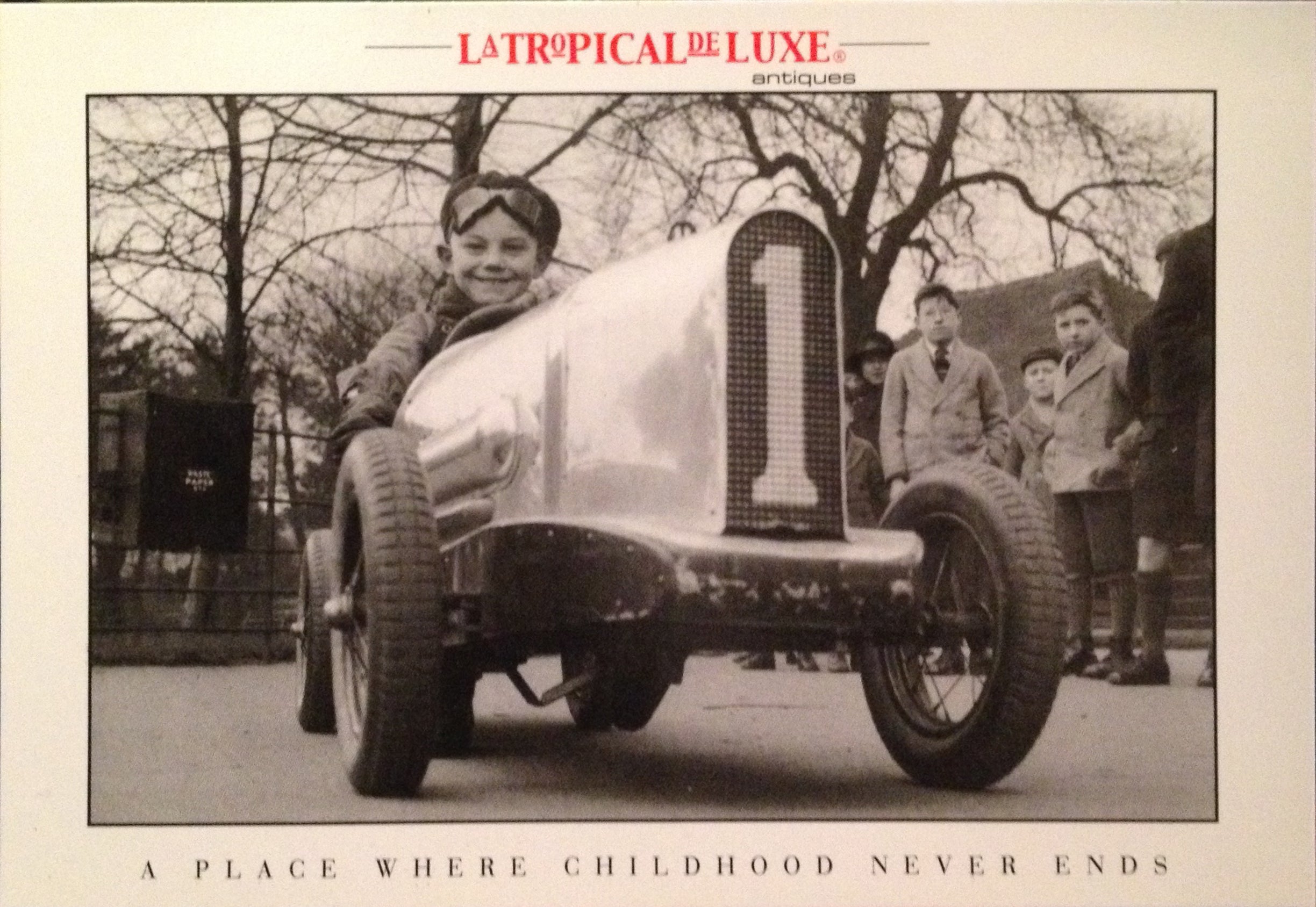
About the Seller
4.9
Vetted Professional Seller
Every seller passes strict standards for authenticity and reliability
Established in 2002
1stDibs seller since 2016
319 sales on 1stDibs
Typical response time: 1 hour
- ShippingRetrieving quote...Shipping from: Buenos Aires, Argentina
- Return Policy
Authenticity Guarantee
In the unlikely event there’s an issue with an item’s authenticity, contact us within 1 year for a full refund. DetailsMoney-Back Guarantee
If your item is not as described, is damaged in transit, or does not arrive, contact us within 7 days for a full refund. Details24-Hour Cancellation
You have a 24-hour grace period in which to reconsider your purchase, with no questions asked.Vetted Professional Sellers
Our world-class sellers must adhere to strict standards for service and quality, maintaining the integrity of our listings.Price-Match Guarantee
If you find that a seller listed the same item for a lower price elsewhere, we’ll match it.Trusted Global Delivery
Our best-in-class carrier network provides specialized shipping options worldwide, including custom delivery.More From This Seller
View AllArt Deco Pierrot Silvered Bronze Sculpture, Signed Alonzo, France 1920´s
Located in Buenos Aires, Olivos
Art Deco Pierrot Silvered Bronze Sculpture, Signed Alonzo, France 1920´s
Bronze mounted over a marble base.
We have specialized in the sale of Art De...
Category
Early 20th Century French Art Deco Figurative Sculptures
Materials
Marble, Bronze
$999 Sale Price
37% Off
Art Deco Theatrical Dancing Figure by Josef Lorenzl, Austria 1920´s
By Josef Lorenzl
Located in Buenos Aires, Olivos
Art Deco Theatrical dancing figure by Josef Lorenzl. Austria 1920´s
Austrian silvered metal figure of theatrical dancer, raised on an marble base.
We have specialized in the sale o...
Category
Early 20th Century Austrian Art Deco Figurative Sculptures
Materials
Marble, Bronze
Demetre Chiparus - Art Deco Bronze Sculpture Lamp France c. 1925 "Delhi Dancer"
By Demetre Chiparus
Located in Buenos Aires, Olivos
Demétre Chiparus - An Art Deco bronze sculpture Table Lamp, France circa 1925 "Delhi Dancer", the bronze dancer mounted on a substantial brown marble base with an illuminated honey o...
Category
Early 20th Century French Art Deco Figurative Sculptures
Materials
Marble, Bronze
$8,000 Sale Price
42% Off
Franz Iffland Bronze Sculpture of a Cupid Boy Ice Skater, ca 1900
By Franz Iffland
Located in Buenos Aires, Olivos
Bronze depicting a young boy (cupid) ice skating, by Franz Iffland (Berlin 1862-1935). A boy in fur-trimmed cape, holds a cupid-like feathered arrow with...
Category
Early 20th Century German Art Nouveau Figurative Sculptures
Materials
Marble, Bronze
Nude Car Mascot / Hood Ornament, by Antoine Bofill, French, Circa 1920
By Antoine Bofill
Located in Buenos Aires, Olivos
Nude comparison car mascot / hood ornament, by Antoine Bofill, French, Circa 1920
Signed 'Bofill' to top of base and with foundry stamp 'R.Patrouilleau Edit_Paris' around the base, ...
Category
Early 20th Century French Art Deco Figurative Sculptures
Materials
Marble, Bronze
$3,299 Sale Price
26% Off
20th Century Tennis Player Bronze Sculpture / Trophy, Italy, 1930s
Located in Buenos Aires, Olivos
Midcentury tennis player bronze sculpture / Trophy. Italy, 1930s.
Very nice Italian bronze figure. Mounted over black Portoro marble.
We have speci...
Category
Mid-20th Century Italian Mid-Century Modern Sports Equipment and Memorab...
Materials
Marble, Bronze
You May Also Like
Pierrot Sculpture, 1920
Located in Saint-Amans-des-Cots, FR
French Art Deco Sculpture "Pierrot", France, 1920s. This charming Art Deco sculpture, depicting "Pierrot", dates from the 1920s and showcases the elegance of French art. Made of spel...
Category
Vintage 1920s French Art Deco Figurative Sculptures
Materials
Onyx, Spelter
$1,700
Eugene Riboulet Art Deco White Clown "Paillasse", Biscuit Proof
Located in Saint-Ouen, FR
Eugene Riboulet Art Deco White Clown "Paillasse", Biscuit Proof
circa 1930
Category
Vintage 1930s French Art Deco Figurative Sculptures
Materials
Ceramic
Antique Rosenthal Porcelain Pierrot Clown Figurine No. 436 by A. Caasmann
By Rosenthal
Located in Philadelphia, PA
A fine antique German Jugendstil porcelain figurine.
Designed by Albert Caasmann for Rosenthal in 1916.
In the form of a Pierrot clown playing an acc...
Category
Early 20th Century German Jugendstil Figurative Sculptures
Materials
Porcelain
Limoges Porcelain Pierrot Musician in White and Gold by Edouard Marcel Sandoz
By Edouard-Marcel Sandoz, Theodore Haviland
Located in Henley-on Thames, Oxfordshire
Edouard Marcel Sandoz
(1881-1971)
Figure "Pierrot Musicien", ca. 1917.
Hard-paste porcelain with a white glaze, and painted gold.
Signed to the base, appears to be Théodore Havil...
Category
Early 20th Century French Art Deco Figurative Sculptures
Materials
Porcelain
Rosenthal Art Déco Figurine Pierrot 'Ash Wednesday' Max Valentin Germany, 1922
By Max Valentin, Selb Porcelain
Located in Vienna, AT
Very rare Art Deco figurine of a lute playing pierrot
In a wide bright robe with Art Deco decoration. Wearing hat and ruff and playing a lute. A white ca...
Category
Vintage 1920s German Art Deco Porcelain
Materials
Porcelain
"Little Clown" by Demetre H. Chiparus
By Demetre Chiparus
Located in Ciudad Autónoma Buenos Aires, C
"Little Clown" by Demetre H. Chiparus (1886-1947). Bronze sculpture and marble base.
Bryan Catley (1978) "Art Deco and Other Figures" p. 66.
Category
Vintage 1920s French Art Deco Figurative Sculptures
Materials
Marble, Bronze
More Ways To Browse
French Art Deco Alabaster
1920s Art Deco Alabaster
Clown Pierrot
Art Deco Pierrot
Art Deco Glass Hood Ornament
Pennsylvania House Rocking Chair
Pierre Augustin
Putti Clodion
Sculpture Minerva
Staffordshire Porcelain Figurines
Vienna Erotic Bronze
Antique Wand
Bronze Diana The Huntress
Bronze Hippolyte Moreau
Capodimonte Porcelain Flowers
Dictionary Stand Antique
Dubois Bronze
Empress Josephine
